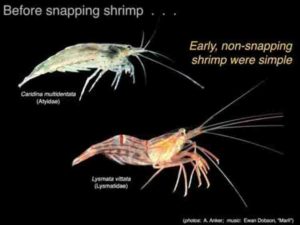
Just how do snapping shrimp snap? This was the question plaguing scientists who set out to uncover the mysterious mechanisms producing big biology in tiny crustaceans.
“All we’ve known until now is the endpoint of these super snapping claws,” said Rich Palmer, biological science professor at the University of Alberta and senior author on a new study on snapping shrimp claws. “What we now know is that a series of small changes in form led to these big functional changes, which essentially allow these shrimp the ability to break water, or snap.”
Through the course of two years of research investigating 114 species from 19 different shrimp families–exploration that took the scientists from the far reaches of Panama to advanced imaging facilities in Germany–the researchers discovered that this ability to break water or snap was preceded by evolution and adaptation millions of years in the making. The shrimp use the snapping for multiple reasons including communication, killing prey, territorial defense, and defending against predators.
“We realized that this spectacular ability to break water by making cavitation bubbles had to have been preceded by maybe millions of years of shrimp just shooting water. Somehow as they continue to shoot water, they got faster and faster, and they eventually broke the cavitation threshold to produce these snaps. It’s pretty extreme biology,” said Palmer.
Palmer explained that a bubble produced from the shrimp’s claw is actually a vacuum where surrounding water pressure collapses the sides of the bubble to produce a snap, something that can only happen when the water is shot so fast from the claw that it leaves before adjacent water can come in behind it. What he and his co-authors uncovered was that such extreme movements depend on both an energy-storage mechanism as well as a latching mechanism to release the stored energy quickly. Sort of similar to a bow and arrow.
“If you take an arrow and try to throw it, it doesn’t go very fast. But if you take the same amount of energy and pull back and then release, the arrow goes very quickly. Throwing just uses muscle contraction whereas storing energy and cocking releases the same amount of energy, but much more quickly.”
Palmer explained that the sum of multiple small changes in claw form–each of which is an innovation–adds up to a force so strong it breaks water by taking advantage of underwater physics, since liquids are not compressible. The end result–this remarkable ability to snap–is what is referred to as a key innovation.
“Key innovations are adaptations that permit a dramatic radiation or diversification of species, setting the stage for radiation into a wholly new kind of adaptive zone that wasn’t there before.”
Reference:
Parallel Saltational Evolution of Ultrafast Movements in Snapping Shrimp Claws. DOI: 10.1016/j.cub.2017.11.044
Note: The above post is reprinted from materials provided by University of Alberta.










